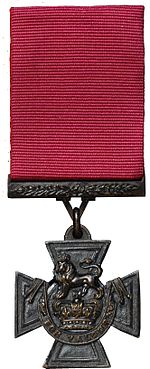John Leak
Leak enlisted in the Australian Imperial Force in early 1915, and served with the 9th Battalion in the Gallipoli Campaign during the First World War.
Suffering from the effects of his service, Leak was convicted of desertion by a court-martial in November, but his sentence was ultimately suspended, and he returned to the 9th Battalion.
[3] By the outbreak of the war, his parents had died,[6] and Leak was living at Clermont, Queensland,[7] and working as a teamster.
[2][3] On 28 January 1915, Leak enlisted in Rockhampton as a private in the Australian Imperial Force (AIF) and was assigned to the fifth reinforcement draft for the 9th Battalion, 3rd Brigade, 1st Division.
[10] He joined his battalion on 22 June while it was involved in trench warfare defending the Anzac Cove beachhead on the Gallipoli Peninsula in the Ottoman Empire.
[9][10] Six days after Leak's arrival, the 9th Battalion was involved in a two-pronged attack against the Ottoman positions on what were known as "Sniper's Ridge" and "Knife Edge", close to Lone Pine.
[10][12][13] On 31 August, Leak reported sick and was evacuated with gastroenteritis, first via hospital ship to Malta, where he was hospitalised and diagnosed with dysentery.
They spent several weeks in a quiet sector of the line near Armentières, before deploying south to the Somme river valley, where they experienced their first fighting in France.
By the time the rest of his platoon got to the post, Leak was wiping blood off his bayonet with his slouch hat.
The fighting around Pozières continued after this incident, and two days later the Germans laid down a tremendous artillery barrage on the positions that had been captured from them, described by the official Australian war correspondent, Charles Bean, as "among the heaviest that occurred either on the Somme or at Verdun".
[16] One of those casualties was Leak, who had suffered a serious wound to the back on 21 August, during a German artillery bombardment near the "Gibraltar" blockhouse.
His courage and energy had such an effect on the enemy that, on the arrival of reinforcements, the whole trench was recaptured.Leak was evacuated to hospital in the United Kingdom on 13 September.
[22] In June, Leak gave evidence at the trial of an Australian soldier accused of wearing a VC ribbon on his uniform when he was not a recipient of the award.
[17] Leak returned to the Western Front in October, after his battalion had fought in the Battles of Broodseinde and Passchendaele in Belgium.
By this stage, Leak was clearly affected by combat-related trauma and was not coping with the effects of the relentless shell-fire, and went absent without leave from his unit as it deployed forward into the front line to relieve Canadian troops on 1 November.
Leak continued to serve on the Western Front with his battalion until 7 March 1918, when he was gassed during a lengthy bombardment of his unit's positions near Hollebeke.
[2][24][25] On 30 December 1918, after his court-martial sentence was finally remitted, Leak married Beatrice May Chapman in Cardiff, Wales.
[26] On 9 February 1919, Leak and Beatrice sailed for Australia aboard the SS Ascanius,[2][27] arriving in Queensland on 26 March.
[28] On 10 April, he attended a reception in his honour at Rockhampton, but declined to speak, then returned to Clermont by train.
[2] On 20 October 1972, Leak died at Redwood Park and was buried alongside Ada in the Stirling cemetery.

